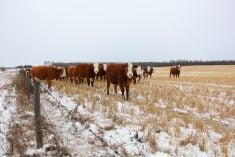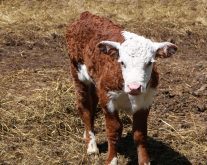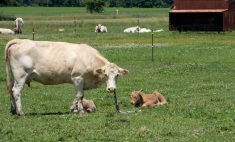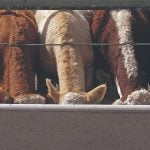A great deal of what gets published about nutrition of the neonatal calf (birth to 28 days) comes from research in the dairy industry. Beef producers should pay attention to what’s being practiced by neighbours in the dairy industry and to topics such as viability of newborn calves. Key to profitability for both beef and dairy producers is a healthy, high-quality calf crop.
Dr. Andrea S. Lear, assistant professor of large animal clinical sciences at the University of Tennessee in an article on neonatal viability writes, “Losses can be associated with not only fetal death during pregnancy, but prolonged open periods as a result of early embryonic death, delayed peak lactation, and increased culling rate.”
Read Also

Canadian Beef Check-Off Agency reports on investments and activities
The check-off agency’s work behind the scenes is what ensures cattle check-off dollars are invested wisely, accounted for transparently and deliver measurable value back to producers and importers.
Lear defines fetal viability and well-being as a combination of two things: How the baby is doing at any point in gestation and the likelihood the baby will survive outside the uterus, once it’s on the ground. A 2020 meta-analysis published in Animal Reproduction Science indicates the overall level of mortality found today on dairy and beef farms is 5.8 per cent. Researchers at Texas A&M University report losses in the dairy industry may range over 10 per cent.
The potential effect of those factors drives home the value of veterinarians being able to assess fetal viability and well-being to increase the possibility of having a productive, healthy calf born at the end of gestation and have them thrive after birth. Re-evaluating the role key nutrients play immediately after birth colours “viability.”
You cannot talk about neonatal nutrition without mentioning colostrum. Calves should consume five to six pints or three quarts of good-quality colostrum within an hour of birth and again within 12 hours. The amount of antibodies absorbed is related to the timing of colostrum feeding after birth. Within six hours after birth, the gut’s ability to absorb antibodies decreases by a third. By 24 hours, the gut absorbs only 11 per cent of what is absorbed at birth. By 24 hours of age, digestive enzymes break down and digest many of the antibodies. Hand-feeding (tubing) newborn calves is necessary for calves unable or reluctant to suckle. A delay in consuming colostrum also affects absorption of other nutrients such as vitamins A, D, E and B12.
It is well known that colostrum quality varies depending on the nutritional status of dam and that sustaining neonatal stores of nutrients depends entirely on colostrum intake.
At birth, a calf’s digestive system is underdeveloped. In reality, neonatal calves are monogastric for approximately two weeks. The calf is unable to produce nutrients by fermentation until it begins to eat dry feeds, particularly grains containing readily fermentable carbohydrates at which time the rumen takes on a more important role. The stomach compartments grow and change as the calf develops into a ruminant animal, which creates unique nutritional needs for pre-weaned calves.
Although iron is the most abundant element by weight on Earth, it is considered a trace- or micro-element in nutrition. Though iron only makes up approximately 0.004 per cent of the body by weight and is required in very minute amounts in the diet, it plays a critical role in human and animal nutrition. Its importance in the diet has been known for over 2,000 years.
The majority of iron in the body is found in heme-containing proteins (hemoglobin and myoglobin). Hemoglobin is the protein contained in red blood cells that transports oxygen from the lungs to the body tissues. Myoglobin transports and stores oxygen in muscle cells. Another group of iron-containing proteins is cytochrome enzymes, which are very important in energy metabolism. Iron is also needed as a co-factor for several enzymes involved in energy metabolism.
Due to poor placental transfer, newborn calves depend mainly upon colostrum and milk to supply fat-soluble vitamin needs. If the dam has not received sufficient fat-soluble vitamins during gestation, colostrum may be deficient in these critically important vitamins, resulting in newborn deficiencies. Weak-calf syndrome is partly due to deficiencies of vitamins E and A. The high content of fat and vitamins A, D and E in colostrum are especially important because the newborn calf has low reserves of these nutrients. Injecting fat-soluble vitamins at birth is one method to enhance fat-soluble vitamin status. Oral supplementation in the form of VITAFERST-CARE (AVL/Solvet) just entered the marketplace.
Vitamin A maintains delicate tissues lining the respiratory, digestive and reproductive tracts — keeping them pliable and in good working order. Vitamin A deficiency thickens these tissues, causing them to become more brittle. This increases susceptibility to infection because the lining that would normally keep pathogens out is affected. If the gut is hard and brittle it cannot absorb nutrients, resulting in poor gain. Calves simply do not perform well without adequate vitamin A.
Vitamin E belongs to the family of lipid-soluble vitamins. Although vitamin E is widely known as a potent antioxidant, studies have also revealed that vitamin E possesses anti-inflammatory properties. These crucial properties of vitamin E are beneficial in various aspects of health, especially maintaining neural and cardiovascular tissues, skin and bone health.
Selenium, in conjunction with vitamin E, helps prevent white muscle disease in soil-deficient areas and promotes growth.
Vitamin D plays a critical role in bone formation and regulating calcium and phosphorus balance in cattle. We have recently learned that vitamin D also helps activate important immune defences of cattle.
All ruminants (including sheep, cattle and goats) require cobalt in their diet for the synthesis of vitamin B12. Newborn animals have low reserves and a high requirement for cobalt. Vitamin B12 is essential for energy metabolism and red blood cell production.
Not much new, but a serious rethink on the viability of neonates.

















